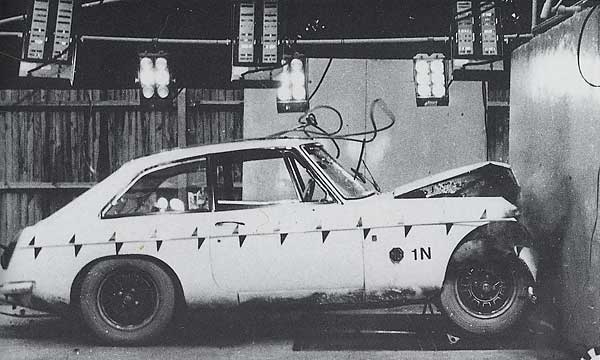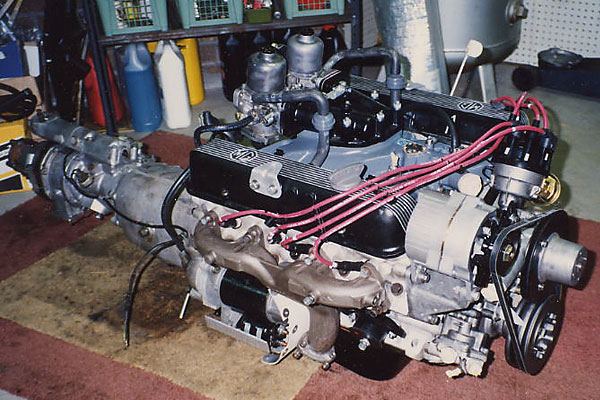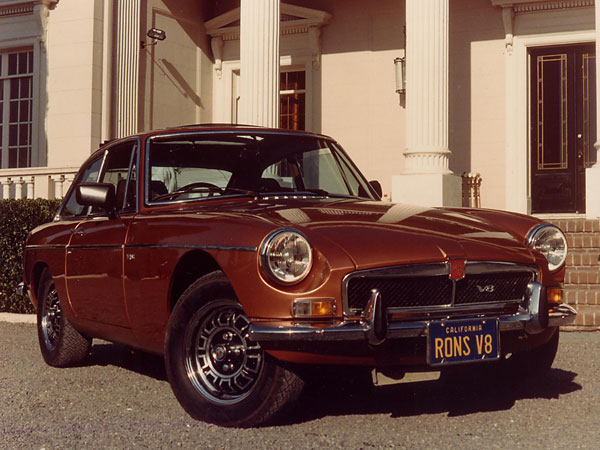�

�
�
Not to be published until Wednesday 15th August 1973�
�
MGB GT V8
�DEVELOPMENT OF THE BODY AND THE ENGINE
�� The engine and the body structure of the new MGB GT V8 were both seen by the public � in 1965. In the Spring Rover engineers showed to a few selected journalists a 3 litre � saloon with a new type of light alloy V8 engine installed and the new MGB GT was � unveiled at the London Motor Show of 1965 as a new Grand Touring car. �
�THE ENGINE
�� Technology these days is international and Rover did not hesitate to look across the � Atlantic when, in the early 'sixties they were looking for a new powerplant to take � their range into the 'seventies. The engine they chose had the merits of lightness and � compactness, but needed development to meet European needs. Despite the robust five � bearing crankshaft and the excellent breathing possibilities inherent to the layout, � engine speeds over 4,800 rpm showed up stresses in the pistons and the valve gear. �
��
Manufacturing technology at the Rover plant was not geared to the methods of �
construction used by the engine's original designers and new methods of thin-wall �
aluminum casting had to be evolved to make it. A development programme was put in �
hand to develop appropriate methods of construction and to bring the engine to European �
standards of output and engine speed. �
�
The original engines developed 150bhp gross at 4,400 rpm and by the middle of 1967 �
Rovers had installed twin carburetters, reduced the compression ratio slightly and �
achieved 160 bhp gross. By the time the Rover 3500 appeared in production in 1968, �
power was up to 184 bhp gross at 5,200 rpm with outstanding reliability and very �
long life. �
�
New pistons, and different materials for the valve train as well as for the bearing �
inserts and for the crankshaft, had been evolved during the search for these improvements. �
�
As installed in the MGB GT V8, the unit has few changes. The most notable are the �
repositioned carburetters and the alternator. With increasingly tough emission and �
pollution regulations now rigorously applied in many parts of the world, MG engineers �
were concerned to make certain that their new engine complied with all possible �
requirements. A reduction in compression ratio, which is now 8.25:1, is a direct �
result of this concern. The 137bhp now claimed for the engine is measured by methods �
comparable to those applied in the DIN rating. �
THE STYLING
��
The good looks of the MGB GT body made an immediate impression when the model was �
launched in October 1965. Evolved from the MGB at Abingdon, it was refined by Pininfarina �
stylists, consultants to MG, who gave the car its timeless appearance. This new model �
became accepted as undeniably the best looking of a visually related trio which included �
the Mini and the Austin 1100/1300. It has been found necessary to make only very few �
amendments to improve the appearance over the years, but the USA Safety Act of 1966 �
and the Clean Air Act of two years later involved an extended and costly programme to �
evolve structures and equipment capable of meeting the provisions of these new �
regulations in a very important market. �
�
� (c)�
�
�
Enjoying this article? Our magazine is funded through the generous support of readers like you!
�
To contribute to our operating budget, please click here and follow the instructions.
�
(Suggested contribution is twenty bucks per year. Feel free to give more!)�

� 30mph barrier testing of the MGB GT V8 model. (Note the distinctive "V8" wheels.)�
�
Editorial Comments:�
�
Without doubt, part three of the five part press release is the weakest link in that chain. �
What committee wrote this? Consider the engine section: of course the writers didn't want �
to say anything bad about Rover or anything good about General Motors, but they missed a �
fine opportunity by failing to note that the aluminum V8 engine in this new sports car �
already had a spectacular racing history, having competed in the Indy 500 and having won �
outright (albeit with substantial modification) two Grand Prix championships. They chose �
instead to imply misleadingly that GM had only been able to get 150bhp gross out of the �
engine, when in fact GM had offered many variants of the engine right up to 215hp (with a �
turbocharger, in Oldsmobile "JetFire" trim.) On the other hand, Rover engineers had detuned �
the engine to just 137bhp DIN (and 8.25:1 compression) for the Range Rover and MGB GT V8.�
�
The "Styling" section is especially odd. Why would anyone compare MGB GT's elegant �
Pininfarina styling to the Mini or the Austin 1100 / 1300? Even more bizarre, why whine �
so pathetically about the USA Safety Act of 1966 or the USA Clean Air Act - especially in �
this section? (Neither act had anything at all to do with the styling of the 1973 MGB GT V8.)�
�
Ironically, this section ends by describing the U.S. as "a very important market". This is �
ironic because the decision had already been made by British Leyland management that the �
MGB GT V8 would never be offered in North America! In effect, this left the door wide �
open for sales of the Datsun 240Z and then 260Z (with their inline 6 engines) to grow �
unchecked by British competition. The Ford Mustang II, which started production in 1974, �
wasn't available with a V8 engine in its first model year. When the oil embargo hit (on �
October 17, 1973), and panicked Americans started trading-in their muscle cars, MG was �
unprepared to capitalize on the surprisingly good gas mileage of the MGB GT V8.�
�
�

�
Ken Smith's aluminum V8 engine complete with MG valve covers, manifolds, and gearbox.
�
Notice that MG used a Delco (GM) alternator. As with the Rover 3500S, which was already
�
being sold in North America, GM would have been paid a nice royalty for every MGB GT V8
�
sold here. Components like the Delco alternator would also have favored GM's bottom line.�
�

�
Ron Hall's MGB GT V8, photographed in 1981 at Lido Mansion in California.
�
This is one of about twenty factory MGB GT V8s that immigrated to the U.S.A.�
� Disclaimer: The "editorial comments" and photo captions were written by Curtis Jacobson. � Views expressed are those of the author, and are provided without warrantee or guarantee. � Apply at your own risk.�
� This article is part of a set of FIVE! If you enjoyed this article, check out:
� MGB GT V8 Press Release - Introduction
� MGB GT V8 Press Release - "Description of the Car"
� MGB GT V8 Press Release - "Grandest Tourer - Latest of a Line"
� MGB GT V8 Press Release - "Technical Specifications"
�
�
� BritishV8 Magazine has assembled the largest, most authoritative collection of MG � "MGB GT V8" information you'll find anywhere. Check it out! � Access our � MGB GT V8 article index by clicking here. �
�
